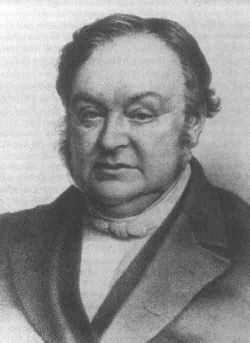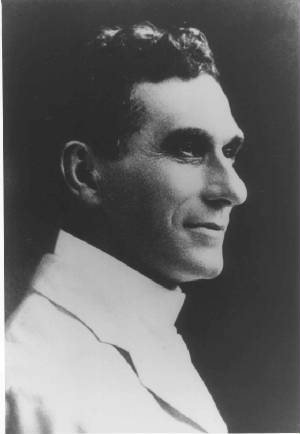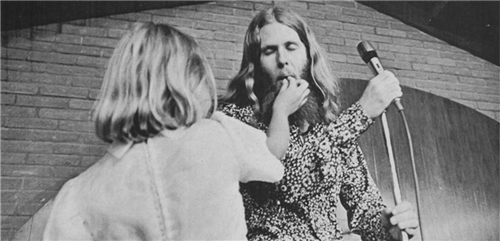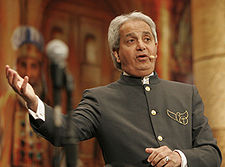|
|
 |
|
1800's
Johann Blumhardt

1843: Johann Blumhardt began praying on a dying girl, placed his hands on her, and she was healed. This created a sensation
which drew people from all over Western Europe. This, even though Blumhardt himself insisted that it was not his hands that
healed, but God's response to honest prayer. Blumhardt saw sickness as a way that our 'fallen' existence bore the Devil's
power into human life. He believed that the way to resist sickness is to confess our sin and repent. As years went by, he
emphasized soul-searching to find the 'hidden sin' that could be making us ill. However, he did not believe that one could
become perfect or sin-free before God in this lifetime; this means that all of us become ill. (Synan, op. Cit)
There seems to be something of the old errors of the Messalian’s in Blumhardts doctrine of sickness as a manifestation
of the devil power; such errors continue today in the "Word of Faith Movement." The influence which Blumhardt ministry
apparently exercised over the first faith-healers of the Holiness may have also also contributed to one of the great misunderstanding’s
about the role of the "laying on of hands" in the Church, since there were those (see above) who attributed healing
properties to Blumhardt hands themselves.
JOHN ALEXANDER DOWIE
Perhaps the most prominent member of the faith healing fraternity in the nineteenth century holiness movement was the controversial
John Alexander Dowie. He popularized end times "restorationism", the idea that, as the Church was now in the final
age of the world, immediately preceeding the second coming of the Lord, the extraordinary signs and wonders of the apostolic
age were to be granted it anew; and preeminent among these would be the gift of healing. A disciple of the radical "faith
healing" which we read about above-the idea that divine healing is the Christian to claim, as spiritual as well as physical
health was won for Christians through the atonement; therefore, as noted above, to pray for healing conditional to God will
was for Dowie a lack of faith, as was seeking medical treatment. Hence Dowie refused to permit his followers to consult with
physicians or avail themselves of any medical treatment. This was to be one of the factors which would eventually contribute
to his downfall, as he established a faith healing center known as " the city of Zion" near Chicago, and would actually
prohibit the ill under his charge to seek medical assistance. There have since been many such "faith healing centers"
in the United States and around the world, and Dowie is generally considered the true father of the faith healing movment.
Dowie was also to exercise an enormous influence on the nascent Pentecostal movement, as many of the prominent leaders of
its first generation were actually members of Dowie commune:
Those who arose from Zion City to become influential in the Pentecostal movement included F.F. Bosworth, John Lake, J.
Rosewell Flower, Daniel Opperman, Cyrus Fockler, Fred Vogler, Marie Burgess Brown, William Piper, F.A. Graves, Lemuel Hall,
Martha Robinson, Gordon Lindsay, and Raymond Richey. Influential Assemblies of God minister Gordon Lindsay, editor of Voice
of Healing, wrote Dowie's biography and gave him credit for influencing "a host of men of faith who have had powerful
ministries," referring to generations of Pentecostal preachers. (Extracted from: The Strange History of Pentecostalism,
distributed online by: Way of Life Fundamental Baptist Information Service, copyright 1998)
In light of the following, this is a startling and significant revelation, as it is documented that not only many of the
Pentecostal pioneer elite were once adherents of a bizarre and cultish commune, whose founder preached a totally heterodox
doctrine of healing and of apostolic restoration, but also that eight of the founding members of the Assemblies of God, the
world largest trinitarian Pentecostal denomination, were also devotees of Dowie. This should give pause to all adherents of
classical Pentecostalism and of the Charismatic movment, since God would never ratify the message of a false prophet. That
so many leaders of incipient Pentecostalism fell under the spell of Dowie attests to the fact that not only was he a peripheral
figure in the beginnings of Pentecostalism, but his influence with regards to the movement adoption of the faith healing banner
was probably decisive. This taken by itself represents should represent a devastating blow to the propagandists of a new Pentecost,
but when coupled with the other little known facts about the origins of Pentecostalism should lead any and all
Christians desirous of being led to the truth that this movement was nothing but a successful deviation of historical
Christianity.
Dowie attitude towards divine healing would lead him to deny those under his "care" any access whatsoever to
doctors or medicine. Such actions are generally not in the interest of the public good, and the state of Illinois was soon
to charge Dowie with the crime of manslaughter. Around this time a group of followers approached Dowie and attempted to convince
him that he himself was the prophet Elijah, come in the spirit and power to restore all things before what they were sure
was the imminent parousia. Dowie initially rejected such ideas, but as time went on and his following increased, it was inevitable
that the spiritual pride that goes with being regarded by so many as a great healer would play on his manifest spiritual immaturity-not
to mention the absence of any check on such illusions by the salutary intervention of a religious or ecclesiastical authority.
Dowie, like most such cult figures, was answerable to no religious authority or board, merely to the power of the state. As
time went on, these factors were to produce the inevitable march from spiritual pride and pseudo-religiosity to downright
diabolical deception and delusion. Dowie eventually made the public declaration, in 1901, that he was indeed the prophet Elijah,
and dressed himself in the robes of the Jewish high priest, whereupon he lost much of his following. However, since common
sense or logical consistency is seldom in abundance wherever charlatans such as Dowie are revered, most of his previous devotees,
in particular those who were most prominent in the subsequent Pentecostal revival, did not deny that he had once possessed
the "anointing", or that the Holy Spirit had enabled him to work miracles. The farthest they were willing to go
was to maintain that Dowie spiritual pride had led to his downfall.
However, there are charlatans and there are charlatans, and it is important to consider that men like Dowie do not gain
their considerable followings merely on account of their fanciful oratory, or their generic "charismatic personality"-
not if they claim to be divine healers and to work miracles. Did Dowie possess some kind of real power? At this juncture,
once can only speculate, but it would appear that he did indeed "heal" certain individuals, most significantly the
wife of John Lake, who was later to become the founder of Pentecostalism in Africa. Lake was to have some rather strange paranormal
experiences himself (which we will document further on). But any faithful and sincere Christian should know that recognizewhatever
powers Dowie did exercise on occasion could not have been of God, since God will not ratify the message of a false prophet,
and there should be no doubt in any sincere Christian mind that Dowie was a false prophet. Dowie was not only reverenced by
early Pentecostals such as Lindsay and Lake- he exerted a considerable influence on the founding father of Pentecostalism,
Charles Fox Parham either directly or via the religious commune of Shiloh, founded by another cult leader, Frank Sandford,
and which will be considered further on. Dowie was to die an embittered and generally forgotten figure, destroyed by the same
illusions of spiritual pride and generally ignored (but by no means repudiated) by most of the members of the movement that
he himself was instrumental in laying the foundations of.
1900's
John G. Lake

John Graham Lake, (1870-1935), usually known as "John G. Lake", was a businessman influenced by the healing ministry
of John Alexander Dowie, received the baptism of the Holy Spirit in 1907 in the wake of the Azusa Street Revival and became
known for his ministry as a missionary and “faith healer.His life and message are represented in a book compiled
by Roberts Liardon, entitled, John G. Lake: The Complete Collection of His Life Teachings.
Lake was originally from Ontario, Canada. He was from a large family, which was continually affected with illness, and
his memory of childhood was that there was always someone in the house either sick, dying or dead. Lake was a very industrious
businessman, and started two newspapers, before beginning a very successful career in real estate. By the time he left for
the mission field he walked away from a $50,000 year salary (around 1 million in 2005 dollars), as well as his seat on the
Chicago Board of Trade.
Early in his career, Lake's wife, whom he deeply loved, and even adored, fell ill with a life threatening illness. Having
a lifetime of suffering and bereavement behind him, he refused to accept this, and took the radical step of taking her to
see John Alexander Dowie. Dowie had a reputation as a wild faith healer and founder of Zion City, Illinois fifty miles north
of Chicago around this belief. Lake's wife recovered and he was drawn into Dowie's movement, and he eventually became an elder
in the church. It was here that he began to practice "divine healing". Although Dowie rejected the Pentecostal message,
a number of early Pentecostal leaders, including F.F. Bosworth, were trained under Dowie.
Lake's greatest ministry was in South Africa, and his ministry there had dramatic and far reaching consequences. The incredible
stories of his ministry are too numerous to recount and difficult to verify. With Thomas Hezmalhalch he founded the Apostolic
Faith Mission of South Africa in 1908, which attracted many of the early Zionists led by Pieter L. le Roux of Wakkerstroom.
Le Roux took over the leadership of the Apostolic Faith Mission when Lake returned to America, and led it for 30 years.
1940's
Kathryn Kuhlmann

Kathryn Johanna Kuhlman (May 9, 1907 - February 20, 1976) was an American faith healer and Pentecostal evangelist. She was
born in Concordia, Missouri to German parents and died in Tulsa, Oklahoma, following open-heart surgery.
She was born-again at the age of 14 in the Methodist Church of Concordia, and began preaching in the West at the age of
sixteen.[citation needed] Kuhlman traveled extensively around the United States and in many other countries holding "healing
crusades" between the 1940s and 1970s. She had a weekly TV program in the 1960s and 1970s called I Believe In Miracles
that was aired nationally. The foundation was established in 1954, and its Canadian branch in 1970.
Kathryn Kuhlman spoke of God and of miracles. In the fifty years of her ministry, she may have personally witnessed to
her Lord's love and power before more than 100,000,000 people. And wherever she went, people who once thought miracles impossible
learned to believe in miracles.
Lonnie Frisbee

|
 |
|
Lonnie Frisbee (6 June, 1949, Costa Mesa, California 12 March, 1993) was an American Pentecostal evangelist and self-described
"seeing prophet" and mystic in the late 1960s and 1970s.[1][2] Despite his hippie appearance and being a closeted
gay man, Frisbee had notable success as a minister and evangelist
Extract from a March 2005 article in the OC Weekly by Matt Coker
Lonnie Frisbee put the freak in Jesus freak. With his long brown hair, long craggily beard, dusty clothing, scent of Mary
Jane and glint of his last LSD trip in his eyes, he showed up out of nowhere, at the height of the 60s, literally on Chuck
Smith doorstep.
Smith was just another conservative Orange County pastor. He moved from a small church in Corona to an even smaller one
in Costa Mesa, yet had impressively boosted membership from three people to more than .
his front-porch meeting with Frisbee in 1968 was awash in the wonderful coincidences Christians point to as proof of God
working in mysterious ways. The hippie was fresh off an LSD-juiced vision in which God told him he turn hordes of young people
on to Christ;
Before long, the two men bonded. Despite his misgivings about hippie hygiene, Smith was always fascinated by the peace-and-love
rhetoric. And this kid Bible knowledge impressed him
They went on to stand side by side off Little Corona beach, dunking thousands of young people in the chilly waters for
the most informal and joyous of baptisms. At his Calvary Chapel, Smith taught about the End Times on Monday nights and Frisbee
packed in the hippies on Wednesday nights. Church membership skyrocketed
Lonnie left after about four years as Calvary unofficial youth pastor and, after a brief time in the Shepherding movement,
wound up at the soon-to-become Vineyard Church of Yorba Linda. Same thing happened there: his presence sparked a worldwide
movement. Calvary and Vineyard have each propagated about 1,000 churches across the planet
But if you were to take a look at the written histories of Calvary, Vineyard and Harvest, you’d find barely
any if any mention of Lonnie Frisbee Vineyard doesn even cite him by name, referring only to the young man.
like John the Baptist walked through Southern California, says Lake Forest historian David Di Sabatino, and nobody wants
to talk about him because he died of AIDS. Di Sabatino recently came out with a documentary entitled Frisbee: The Life and
Death of a Hippie Preacher.
1980's
Benny Hinn

Toufik Benedictus "Benny" Hinn (Arabic: Hebrew: born December 3, 1952) is a televangelist, best known for his regular
"Miracle Crusades" & revival meeting/faith healing summits that are usually held in large stadiums in major
cities, which are later broadcast worldwide on his television program, This Is Your Day.
http://www.bennyhinn.org
1990's
Rodney Howard-Browne
Holy Laughter
Rodney Howard-Browne, born on 12 June 1961 in Port Elizabeth, South Africa, and was raised in the Eastern Cape and Transkei,
is a charismatic Christian preacher and evangelist who has resided in Tampa, Florida, USA since the mid-1990s. He is pastor
of The River at Tampa Bay, a church which he and his wife founded in 1996, and heads Revival Ministries International.[
As a young boy in South Africa, Rodney Howard-Browne states he was called by God to work in the mission field. In 1981 Rodney
Howard-Browne met and married Adonica and immediately went into the full-time traveling ministry. In 1983, they started a
church in the Northeastern Cape and pastored there for two years. They both felt a strong calling to the mission field of
the United States of America. Though he had previously visited America twice before, in 1987 he arrived, with his family,
at Orlando International Airport, with $300USD to his name.
In 1989, in upstate New York, revival broke out. Since the time of this revival meeting, he has held revival meetings
in North America, Central America, South America, various locations in Africa, the United Kingdom, Europe, Scandinavia, Asia,
Australia, New Zealand, the Philippines and Israel.
Rodney Howard-Browne is the pastor of a church in Tampa, Florida, The River at Tampa Bay, which he founded on 1 December
1996 with 500 people attending the first service. Weekly broadcasts of his meetings can be found online.
The Toronto Blessing
TACF was a church founded in Toronto, Ontario, Canada around 1988 by Pastors John & Carol Arnott. The Church was licensed
with the Vineyard & by 1994 it had fewer than 150 people. In January 1994 a Vineyard Pastor by the name of Randy Clark
was asked to come & share. John Arnott had heard that he was blessed while at a conference with Rodney Howard-Browne.
Clark had been a Vineyard pastor for eight years but was on the verge of a nervous breakdown. In the beginning it had taken
him 11 months to get 11 people in his church. But after growing it large he had gotten away from what he had originally started
the church in: Signs, Wonders, and Miracles. But now he was desperate and he had been touched while at this conference with
Rodney Howard-Browne. Clark ended up staying months and today the church holds at least 8 conferences a year. Early in 2006
John & Carol resigned as the Senior Pastors, moving on to a new ministry, "Catch the Fire".
TACF pastors John and Carol Arnott were inspired by a revival in Argentina. They invited Randy Clark of St. Louis, Missouri,
to minister at TACF in January 1994. Randy Clark has been influenced by the ministry of Rodney Howard-Browne, a South African
preacher, founder of the Rodney Howard-Browne Evangelistic Association in Louisville, Kentucky, and the earliest known proponent
of the “holy laughter” revival phenomenon, and introduced some of his approach into TACF practice.
Some visitors have carried the influence of the revival back to their home congregations. Areas that have become known
for Toronto Blessing type revivals worldwide include Pensacola, Florida, in the United States and Bath in England. The Blessing
has become known for ecstatic worship, including what is known as falling or resting in the Spirit, laughter, shaking, and
crying.[1] One TACF teaching, the Golden Sword Prophecy, has been spreading among Charismatic churches.[2]
The peak of Toronto Blessing prominence in the Christian community occurred in the mid to late 1990s. Since that time
it has faded from public view, although the proponents of Discernment Ministries would suggest that these kinds of events
are simply part of a wider theological cycle that has existed continually throughout modern era Pentecostalism / Charismatism.
[3
|
 |
|
|
 |
|
|
 |
|
|
|
|
|
|
 |

